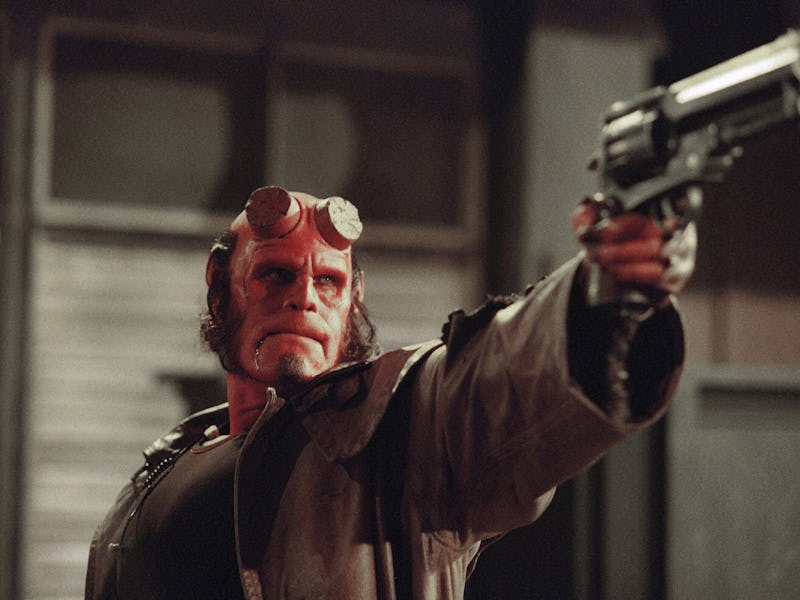Superhero Movies Can Escape Their Box Office Malaise By Learning From Guillermo del Toro
Take your story seriously, no matter how silly it is.

The once-dominant superhero film has suffered a host of injuries lately, from the middling performance of Ant-Man and the Wasp: Quantumania to the thunderous box office crashes of Shazam: Fury of the Gods! and The Flash. Many potential factors have been assigned blame, like behind-the-scenes drama, studio interference, excessive output, or superhero fatigue, but such a complex stew leaves little clear direction forward for Marvel or DC Studios. If the modern superhero movie needs saving, it could do worse than take influence from a very different kind of superhero film: monster maestro Guillermo del Toro’s Hellboy.
In 2004, years before the Marvel Cinematic Universe started with 2008’s Iron Man, Hellboy provided our cinematic introduction to the Bureau for Paranormal Research and Defense. The BPRD, founded by Professor Bruttenholm in 1945 to thwart Hitler’s occult machinations, investigates and combats otherworldly and occult threats. The team’s superpowered members include the half-demon Hellboy (Ron Perlman), firestarter Liz Sherman (Selma Blair), and fishman Abe Sapien (Doug Jones, with David Hyde Pierce’s voice). The team works to prevent Grigori Rasputin (Karel Roden) from unleashing the world-ending dragons Ogdru Jahad, despite the fact Hellboy’s Right Hand of Doom is destined to begin Ragnarok and unleash their reign on Earth.
While Hellboy adapts an arc of Mike Mignola’s esteemed comic run, fans of Guillermo del Toro can find several connections to the director’s work. Thematically, it’s another great example of his persistent interrogation of the connections between humanity and the monstrous. The film also boasts regular del Toro collaborators Ron Perlman and Doug Jones, alongside stunning creature design and practical effects that feel handmade. It’s thoroughly drenched in an auteur’s vision, so herein lies the first lesson: prioritize creators over IP considerations.
Marvel Studios and Warner Bros. should be lauded for their willingness to bring in indie directors with strong visions, like Chloe Zhao, Taika Waititi, and David F. Sandburg. At the same time, filmmakers need to be allowed a clear mandate free of obvious IP and Cinematic Universe considerations.
For both pacing and thematic reasons, Chloe Zhao’s slow, intimate character-building scenes in Eternals didn’t sit well beside Marvel’s mile-a-minute IP-developing moments. Thor: Love and Thunder was profitable, but fumbled its more serious themes due to its uneven tone and an overstuffed, lore-focused narrative. Black Adam and The Flash were similarly bogged down by a rampant array of fan service fans didn’t ask for. Marvel and DC need to follow the example of Hellboy and allow organic worldbuilding and clear directorial vision, so audiences don’t feel like each entry is an overstuffed cash grab instead of a story meant to be enjoyed on its own terms.
Hellboy may crack jokes, but he and his team take their jobs seriously.
Hellboy and its 2008 sequel, Hellboy II: The Golden Army, are also unafraid of embracing what makes comic books so wonderful: their very serious weirdness. These movies have immortal automatons, a magical creature uprising, and odd creatures galore, but the fantastical elements are taken seriously. Hellboy cracks jokes and loves cats, but he’s lovelorn and angsty.
The MCU has embraced some of the weirder creations in Marvel comic history, like the odd beings of the quantum realm in Quantumania or the strangeness spread throughout the Guardians of the Galaxy films. But Marvel’s at its best when the otherworldly elements are treated seriously by both characters and filmmakers, like in the excellent Werewolf By Night. Both Hellboy and Peter Quill may crack wise at the weirder things in life, but they take their enemies seriously, and thus so do we. Hellboy’s second lesson is to consistently and unironically embrace comic book strangeness.
Finally, del Toro’s turn at the superhero helm sees a welcome embrace of different genre elements. Hellboy was inspired by visual effects titan Ray Harryhausen, which you can see in the nigh-immortal assassin Kronen. Our heroes are frequently terrorized by the malicious multiplying demon Sammael, who sports a terrifying, inhuman design, complete with eerie practical effects. The classic horror and fantasy-inspired effects, and avoidance of pure CGI, give the antagonists a more threatening feel than the typical comic book movie baddie.
These designs also touch on a reality rarely broached in comic movies: these larger-than-life threats wouldn’t just be dangerous, but terrifying. Events well beyond the experiences of everyday life should have a greater feeling of awe and magic, which Hellboy provides to full effect. Embracing the weird, allowing directors true carte blanche, and experimenting further with other genres is exactly what our cinematic superheroes need.
Hellboy is streaming on Max until August 31.